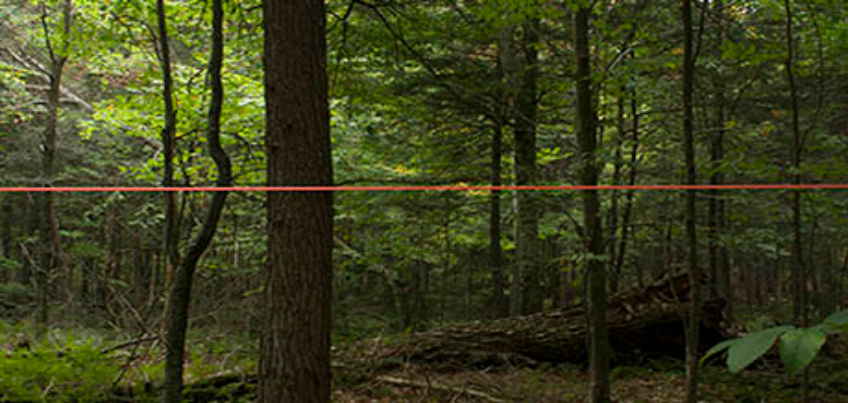
Exhibition Information

Rob Licht: Wilderness Bisect
October 30, 2013-May 17, 2014
Artist Rob Licht collaborated with SUNY Cortland art and art history students to create the outdoor installation described below:
"This project took place on September 21, 2013, in the woods of Camp Huntington, Raquette Lake, NY. Two teams worked simultaneously from the north and south shore of Long Point, stringing 2200 feet of surveyor's tape in a straight line. Where they met, a stick-construction arch was constructed and a golden spike was ceremoniously driven into a log to commemorate the completion of the bisect. After documentation, all traces of the project were removed.
Lines in the form of marked or implied boundaries, roads and other constructions define human activity in the landscape. Lines establish ownership, boundaries of preservation and define areas of accepted or forbidden activity. Often, the history of a place can be read in layers of markers: crumbling stone walls, abandoned roads, witness trees, embedded barbed wire, and abrupt changes in vegetation. The Land Ordinance Act of 1805 set into a play a precise mapping and measuring of the country into a grid of one mile squares, often with little regard for local topography. This parceling facilitated the commoditization of the landscape in an effort to promote expansion and development of the wilderness. Abstract lines drawn on a map became inroads into the wilderness, allowing access and exploitation of untrammeled places.
Wilderness Bisect touches on the rich and complex history of the Adirondacks and questions the changing nature of wilderness in light of the past 200 years of human activity. The straight north-south orange line simultaneously brought the viewer into a relatively pristine tract of northern forest while at the same time confronted them with the manifest abstraction of purely human construct imposed on the natural environment.
Tycoons such as Thomas Durant, notorious for the Transcontinental Railroad, seized upon government incentives to reap enormous profits from the building of railroads. Under the pretense of building the Adirondack Railway, Durant acquired half a million acres from the state. He, and his son, William, builder of Camp Huntington, used their land holdings to gain influence and power, attracting other wealthy magnates to the region to build their own wilderness empires. These vast tracts were at the center of the battle between the preservationist and the conservationist, whose opposing ideologies pitted the concepts of wilderness as sanctuary versus extractive resource. The creation of the Adirondack Park affirmed the belief that wilderness is essential to the human spirit. Ironically, the massive land holdings of the super wealthy made it possible for the state to eventually purchase large intact parcels of land and set aside the wilderness areas that the commoner can enjoy today.
Wilderness is a relative concept. In officially designated areas, all human activity is subject to scrutiny, despite past usage. Although Wilderness Bisect was an ephemeral act, its impact is not null. The participants were required to step off the established trail and follow a line that disregarded the topography, paying heed to only the north-south axis of the earth. In doing so, the project became a transect, facilitating the observation of things that might otherwise go un noticed: an ancient birch tree, a snake, a rusting hulk of abandoned machinery. In that way the bright orange tape was simply a framing device, calling focus to the beauty and complexity of the forest, pulling our attention to where it might not otherwise go."
Rob Licht
Office Information
Dowd Fine Arts Center, Room 106,
48 Graham Avenue and Prospect Terrace Cortland, NY 13045
Phone: 607-753-4216
Fax: 607-753-5934
Contact:
Scott Oldfield, Interim Director
scott.oldfield@cortland.edu
Hours:
Mon, Tue, Wed, Fri: 10 a.m.-5:30 p.m.
Thr: 10 a.m. - 7 p.m.
Walk-ins are welcome. You may also schedule a visit.
The gallery is closed when the College is not in session

